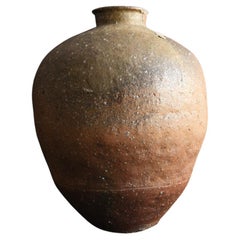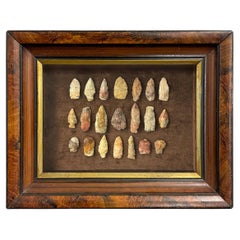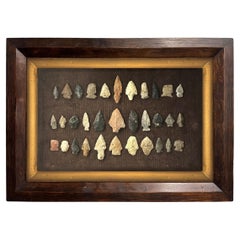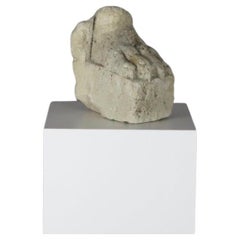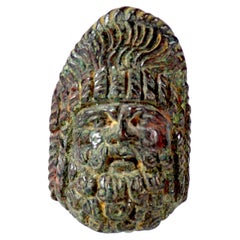15th Century and Earlier Furniture
13
2,760
to
340
1,223
873
2,760
2,760
2,760
20
7
4
4
4
2
2
1
1
1
1
1
1
1
38,958
130,237
516,886
267,926
82,132
254,468
119,114
12,540
5,827
18,020
22,683
19,374
53,766
72,198
59,408
21,241
8,694
1,081
766
640
344
308
1,343
623
518
382
299
29
8
4
3
3
Period: 15th Century and Earlier
Schorl Tourmaline with Aquamarine, Pakistan
Located in New York, NY
SCHORL TOURMALINE WITH AQUAMARINE
Shengus, Roundu District, Gilgit-Baltistan, Pakistan
19.2 cm tall x 6.2 cm wide
Gilgit-Baltistan (formerly known as the Northern Areas) is home to m...
Category
Pakistani Antique 15th Century and Earlier Furniture
Materials
Other
AR Stater Agathokles, Sicily, Syracuse
Located in UTRECHT, UT
Obverse: helmeted head of Athena right
Reverse: Pegasos flying left, triskeles below
VERY RARE
Beautiful toning
Weight: 6.80 g
Grade: Good Extremely Fine
Reference: Pegasi 19 va...
Category
Greek Classical Greek Antique 15th Century and Earlier Furniture
Materials
Silver
Antique Stone Carving of a Claw
Located in Pittsburgh, PA
Ancient Stone Carving Fragment of a Claw. France, circa 15th Century.
Category
French Rustic Antique 15th Century and Earlier Furniture
Materials
Stone
Edmontosaurus Skull
Located in London, GB
An impressive skull of an Edmontosaurus, a large herbivorous dinosaur that lived during the Late Cretaceous period, 68-66 million years ago. The three rows of sixty or more teeth on either side of the jaw, known as the ‘dental battery’, mark the Edmontosaurus as part of the Hadrosauridae, or duckbill family of dinosaurs. It belongs to the flat-skulled, or solid-crested, Hadrosaurinae, which replaced the older hollow-crested hadrosaurs. Edmontosaurus was one of the last non-avian dinosaurs to ever exist, living shortly before the Cretaceous-Paleogene extinction event.
The Edmontosaurus was named in 1917 by Lawrence Lambe, after a partial specimen from Edmonton in Alberta, Canada. The existence of large Edmontosaur bone beds...
Category
American Antique 15th Century and Earlier Furniture
Materials
Bone
Framed Collection of Twenty-One Native American Arrowheads
Located in Chicago, IL
An exceptional set of twenty-one stone arrowheads, discovered in Wisconsin's Waukesha County and framed within a 19th-century faux grain painted shadowbox, these arrowheads not only ...
Category
American Native American Antique 15th Century and Earlier Furniture
Materials
Stone
A Roman bronze applique in the shape of a theatre mask
Located in UTRECHT, UT
Mask of a bearded deity, short beard and hair braided in the characteristic high hairstyle, with layered ringlets on either side.
4 cm (h)
Green patina
...
Category
Italian Classical Roman Antique 15th Century and Earlier Furniture
Materials
Bronze
A Rare and Finely Detailed Greek Bronze Statuette of an Actor with Large Phallus
Located in London, GB
A Rare and Finely Detailed Greek Bronze Statuette of an Actor with Large Phallus
Bronze
Greek
First half of 4th Century BC
Size: 10.5cm high - 4¼ ins high
Provenance:
Ex Privat...
Category
Greek Antique 15th Century and Earlier Furniture
Materials
Bronze
Large Natural Amethyst Plate Specimen
Located in Wormelow, Herefordshire
A large scale natural amethyst specimen originating from Brazil. Crystals from Brazil are most often found as radiating masses, with individual crystals appearing as pyramids. This e...
Category
Brazilian Antique 15th Century and Earlier Furniture
Materials
Amethyst
2nd Centhury Mosaic depicting two animals (a dog and a hen) mounted as table
Located in Ramillies, BE
Mosaic depicting two animals (a dog and a hen) mounted as table.
Near East (Apamea?), 2nd century AD, Roman Period
Marble moulding added in 2015
Provenance : Galerie Rive Gauche, B...
Category
African Antique 15th Century and Earlier Furniture
Materials
Marble
Beautiful Ikat Munisak, Uzbekistan, 19th Century
Located in San Pedro Garza Garcia, Nuevo Leon
A beautiful Ikat Munisak – a woman’s uzbek robe – in traditional pomegranate design symbolizing fertility. It has a square patch in Magenta with a flower mo...
Category
Asian Antique 15th Century and Earlier Furniture
Materials
Cotton
Eastern Han Dynasty Terracotta Barn Workshop, China '206BC - 220AD' Ex-Museum
Located in San Pedro Garza Garcia, Nuevo Leon
Slab pottery constructed barn workshop having a peaked roof – open walled form with a mechanical pounder and a large round covered storage container. Light blue-green mottled glazed surface with some iridescence patina to the glaze.
Condition: Intact, excellent condition, an unusual example.
Provenance: The Living Torah Museum, Brooklyn; ex. Sands of Time, 2002.
Sculptural effigies of domesticated animals were often interred in the tombs of nobility and elite members of the social hierarchy. Models like this one were made to represent everything from simple goat or pig pens to the most elaborate towers and palaces. Because very few ancient Chinese buildings have survived intact, these models, along with descriptions from ancient texts, give a good representation of what the buildings might have looked like.
This fantastic piece is accompanied by a Certificate of Authenticity.
Burial figurines of graceful dancers, mystical beasts, and everyday objects reveal both how people in early China approached death and how they lived. Since people viewed the afterlife as an extension of worldly life, these figurines, called mingqi, sometimes referred as “spirit utensils” or “vessels of ghosts” disclose details of routine existence and provide insights into belief systems over a thousand-year period. For the first time in Chinese history, we have images of rural and daily life during the Han in the form of contemporary...
Category
Chinese Han Antique 15th Century and Earlier Furniture
Materials
Terracotta
Elegant Terracotta Standing Court Dignitary, Tang Dynasty, EU Passport
Located in San Pedro Garza Garcia, Nuevo Leon
Elegant Standing Court Dignitary with joined hands in blue robes and a bird headdress. Polychrome Traces.
When China was unified again, first briefly ...
Category
Chinese Tang Antique 15th Century and Earlier Furniture
Materials
Terracotta
Ikat Chyrpy, Central Asia
Located in San Pedro Garza Garcia, Nuevo Leon
Striking hand-woven chyrpy with a checkered triangle pattern in vibrant colours. Women in Uzbekistan and Northern Afghanistan wore this outdoor veiling garment (paranja/chrypy) in tr...
Category
Asian Antique 15th Century and Earlier Furniture
Materials
Cotton
Japanese antique pottery "Tamba" ware/15th to 16th century/rare Jar
Located in Sammu-shi, Chiba
I would like to introduce rare and interesting Japanese antique pottery.
This is called "Tamba ware" in Japan.
Tamba is a historic kiln located in Hyogo prefecture, Japan. (The part ...
Category
Japanese Other Antique 15th Century and Earlier Furniture
Materials
Pottery
European Carved Limestone Celtic Votive Head of a Male Warrior
Located in London, GB
A Large European Carved Limestone Celtic Votive Head of a Male Warrior Wearing a Typical Flowing Moustache Small Beard and Curling Locks of Hair Stiffened with Lime Wash the Slit Mou...
Category
European Antique 15th Century and Earlier Furniture
Materials
Limestone
Pair of Qingbai Funerary Vases with Daoist figures, Southern Song-Yuan Dynasty
Located in seoul, KR
A pair of large Qingbai jars from the Song or Yuan Dynasty, designed for tomb offerings, featuring tall proportions with short bodies and extended necks. These Mingqi jars, typically...
Category
Chinese Ming Antique 15th Century and Earlier Furniture
Materials
Ceramic, Porcelain
Spanish Azulejo Arabe / Mudejar Tile - Arista y Cuenca - 15th century
Located in DELFT, NL
Early Arabe / Mudejar style tile with geometric decoration, made late 15th century.
Category
Spanish Renaissance Antique 15th Century and Earlier Furniture
Materials
Earthenware
Pair of antique Shell Bracelets from South-East-Asia
Located in Schellebelle, BE
An exceptional pair of South-East-Asian Bracelets made of Shell,
from the Thailand Region , Bang Chiang Period,
prehistoric period,5000-7000 years old,
the hand-carved bracelets have...
Category
Thai Antique 15th Century and Earlier Furniture
Materials
Shell
11C Shiva Tripurantaka Red Sandstone Relief
Located in Dallas, TX
It features a depiction of Tripurantaka Murti, as a manifestation of Lord Shiva.
This relief was carved from red sandstone, most likely in Central India, circa the 10th or 11th Cent...
Category
Indian Archaistic Antique 15th Century and Earlier Furniture
Materials
Sandstone
Rare 15th Century Solid Oak Medieval Dutch Gothic Chest or Trunk
Located in Casteren, NL
A very rare chest that was completely made of solid oak from the Netherlands middle ages.
It is a joined chest with hand carved geometric gothic front panels. The ornaments used are typical Gothic ornaments such as trefoil, mouchette, and trace.
This diminutive chest was probably made in the 15th century Netherlands. It has the typical construction of very early European furniture as is also seen on the German Stollentruhe.
The chest has only a small lid with forged hinges...
Category
Dutch Gothic Antique 15th Century and Earlier Furniture
Materials
Wrought Iron
Pre-Columbian Nayarit Seated Figure Redware Statue
Located in New York, NY
Ancient pre-Columbian, Nayarit, Mexican, circa 100 BCE to 250 CE, hand-built ceramic pottery redware sculpture of a seated male figure with arms crossed and wearing a headdress and m...
Category
Pre-Columbian Antique 15th Century and Earlier Furniture
Materials
Ceramic, Pottery
15th Century French Gothic Oak Cupboard / Dressoir
Located in Hoddesdon, GB
Gothic Oak Dressoir: 1460 - 1500 ,
France - Flandres
This exquisite Gothic oak dressoir dates back to the 15th century. This remarkable piece is a rare survivor from the Haute épo...
Category
French Gothic Antique 15th Century and Earlier Furniture
Materials
Iron
Pair of Very Refined Tang Dynasty Pottery Statue of Guardians, Oxford TL Tested
Located in Greenwich, CT
A pair of very refined standing pottery statue of guardians, dramatic facial expression, beautiful detail, early Tang dynasty 618-907, come with one Oxford authentication TL test cer...
Category
Chinese Tang Antique 15th Century and Earlier Furniture
Materials
Terracotta
Neolithic Pottery Amphora, 3rd-2nd Millenium BC
Located in seoul, KR
This Neolithic pottery presents a robust form with a rounded bottom, tapering to a wide, open top. It features two small loop handles symmetrically placed on either side. The vessel'...
Category
Chinese Antique 15th Century and Earlier Furniture
Materials
Earthenware, Pottery
207.32 Gram Aquamarine Specimen Attached With Matrix From Afghanistan
By Deloris "Dee" Giltz 1
Located in Peshawar, PK
Weight: 207.32 Gram
Dimension: 8.2 x 6.7 x 3.2 Cm
Origin: Afghanistan
Aquamarine is a pale-blue to light-green variety of beryl. The color of aquamarine can be changed by heat. Aqu...
Category
Afghan Adam Style Antique 15th Century and Earlier Furniture
Materials
Rock Crystal
Tyrannosaurus Rex Tooth in Fossil Matrix
Located in London, GB
Tyrannosaurus Rex Tooth in Fossil Matrix.
Late Cretaceous, circa 65 Million years before present.
Lance Formation, Marchant Ranch Quarry, Niobrara County, Wy...
Category
Antique 15th Century and Earlier Furniture
Materials
Other
Exceptional Egyptian Sarcophagus Mask
Located in London, GB
Exceptionally Fine Wooden Sarcophagus Mask
Third Intermediate Period, 21st Dynasty, circa 1069-945 BC.
Acacia wood, rosewood, hippopotamus ivory
Masterfully carved from a single piece of fine-grained hardwood, the present mask is characteristic of the most exquisite funerary art made during the 21st Dynasty, and was probably commissioned for a particularly high-ranking individual.
The oval face displays a gently smiling mouth with full, outlined lips, furrows at the corners and a bow-shaped philtrum. The straight nose with rounded nostrils, the cheeks full and fleshy and the large, almond shaped eyes with heavy lids and tapering cosmetic lines, set below long, sweeping eyebrows.
Social collapse across the Mediterranean in the Late Bronze Age meant that the 21st Dynasty in Egypt was a period of great turmoil. Trade routes were disrupted, governments collapsed, and mass migration occurred. Economic scarcity meant that traditional funerary practices in Egypt were also affected, with a lack of material and financial resources leading to the reuse of preexisting material. As a result, during the 21st Dynasty, 19th and 20th Dynasty coffins changed ownership rapidly and were heavily recycled for new purposes. Tombs were also unmarked allowing them to be shared
by many people. These new practices brought forth a shift in the understanding of funerary paraphernalia. No longer important objects owned forever by the deceased, they were now simply seen as short-term transformative devices, whose symbolic and ritualistic meaning could be appropriated for others. However, paradoxically, the art of coffin-making also reached new heights during this period, and many of the richly dec- orated “yellow” coffins, characteristic of the 21st Dynasty, are remarkable works of art in their own right. Indeed, knowing that coffins were being reused throughout Egypt, the Egyptian élite set themself apart by commissioning lavish sarcophagi decorated with the images and texts meant to help guide them to the afterlife, and which would otherwise have adorned the tomb walls. As coffins were the chief funerary element which now identified the dead and allowed them a physical presence in the world of the living, their quality and appearance were of the utmost importance.
The traditional coffin ensemble was made of three parts: a wooden mummy cover, which laid directly atop the mummy, an inner coffin, and an outer coffin, both made of a lid and case. Additional decorative elements, such as masks, were carved out separately and later glued or pegged to the lids. After the completion of the painted decoration, the sarcophagus was covered in a varnish to give it its yellow colour. Gilding was sometimes used for the coffins of the high priests’ families, notably on parts representing naked skin, such as the face mask. However, some of the élite tactically avoided gilding altogether as to ensure that their coffin would not be looted.
When manufacturing the inner and outer coffins, particular attention was paid to the woodwork. Displaying the skill of the carpenter, this type of funerary art has largely remained unparalleled throughout Egyptian history. The principal wood used to craft the present mask is Acacia nilotica. The evergreen Egyptian acacia was considered sacred and said to be the tree of life, the birthplace of the god Horus, as well as symbolic of Osiris, the god of the dead and resurrection. The modelling of the face in the wood is superb, but the inlays also help mark this mask out as exceptional. Inlaid eyes and eyebrows were extremely rare and reserved to the finest and most expensive coffins. Traditionally, eyes were made of calcite, obsidian, or quartz, and eyebrows of coloured glass paste or bronze. Here, the pupils, eyebrows, and cosmetic lines are inlaid with Dalbergia melanoxylon, a rare type of wood which belongs to the rosewood genus.
In antiquity, however, it was known as Ebony of the Pharaohs, from the Egyptian word “hbny”, meaning dark timber, because of its black, lustrous appearance. An extremely dense and hard wood requiring significant skill to work with, ebony was a luxury material highly coveted by the pharaohs themselves, to make furniture, decorative and funerary objects. The wood was imported with great effort from the southern Land of Punt, most likely modern Sudan, Ethiopia, Djibouti, and Eritrea, alongside other luxury goods such as gold and ivory.
A magnificent ebony throne, recovered in the tomb of King Tutankhamun, illustrates the incredible aesthetic potential of this material and why it was so highly valued by Egyptian royalty. Only élite members of Egyptian society could have afford- ed Ebony of the Pharaoh inlays for their funerary mask.
The sclerae on the present piece were once both inlaid with hippopotamus ivory. Whiter than elephant ivory, this type of ivory is also denser, and more difficult to carve. The use of this luxury material, reputed for its gleaming appearance, enhances the lifelikeness of the eyes. For the Egyptians, hippopotamus ivory was imbued with magic powers. The hippopotamus was indeed both feared and venerated due to its aggressive behaviour. Whilst the male hippopotamus was associated with danger and chaos, the female was benevolent and invoked for protection, especially of the house and
of mothers and their children, through the hippopotamus goddess Tawaret. Thus, not only was hippopotamus ivory used as an inlay and to make practical objects, such as combs and clappers, but it was also used to make talismans like apotropaic wands or knives.
Made during a time of scarcity where few could afford made-to-order coffins, the present mask could have only belonged to one of the highest-ranking individuals in society. Undoubtedly one of the finest Egyptian coffin...
Category
Egyptian Egyptian Antique 15th Century and Earlier Furniture
Materials
Fruitwood, Hardwood
Collection of 7 Small Cabinet Mineral Specimens
Located in Wormelow, Herefordshire
A varied and colourful collection of 7 natural mineral specimens, each presented on an exclusive small wooden display base.
Ex. private British collection, this group contains a ran...
Category
Norwegian Antique 15th Century and Earlier Furniture
Materials
Natural Fiber
Japanese antique pottery vase/14th-15th century/Tokoname ware/Wabi-Sabi
Located in Sammu-shi, Chiba
It is a very old jar in Japan.
This is a pottery called Tokoname ware.
Tokoname is a kiln located in Aichi prefecture, Japan.(Tokoname Kiln is marked with a red circle on the map.)
I...
Category
Japanese Other Antique 15th Century and Earlier Furniture
Materials
Pottery
Complete Slice of Imilac Meteorite
Located in London, GB
This complete cross-sectional slice from the Imilac meteorite has been prepared to reveal shimmering olivine and peridot gems embedded in an iron-nick...
Category
Antique 15th Century and Earlier Furniture
Materials
Other
Ancient South Arabian Alabaster Inscription
Located in London, GB
South Arabian Alabaster Inscription
Calcite Alabaster
circa 1st century A.D.
‘’Consequently, neither white marble of Paros nor any other stone which men admire can be compared with the precious stones of Arabia, since their whiteness is most brilliant, their weight the heaviest, and their smoothness leaves no room for other stones to surpass them.’’
- Diodorus Siculus, Library of History, Book II, 52.9
This inscription, finely worked on an alabaster tablet, is a remarkably well preserved example of Ancient South Arabian script, with its distinct bold, angular forms, written in the Qatabanic dialect - that is, the dialect spoken by the people of the kingdom of Qataban, which ruled much of modern day Yemen from the 7th Century B.C. to the 2nd Century A.D. The text, which reads: ‘[... ...]sa?d and Ma?add?i- / (of the lineage) of Hawfa- / She entrusted Anb- / against any malfeasance (which would remove it) from its place’ - indicates that it likely served to commemorate a temple offering. The quality of the script, incised so neatly into the surface of the alabaster, tells us that this piece was commissioned by somebody of considerable wealth and prestige, employing a scribe of equally considerable expertise.
South Arabia was known throughout the ancient world for its incredible wealth - so much so that the Romans termed the region ‘Arabia Felix’ - literally, ‘Happy, or Fortunate, Arabia.’ That wealth was built largely on the trade of spices and incense, in which the Kingdom of Qataban played a major part. According to Pliny the Elder, this was the sole country through which frankincense could be exported, first being collected in the city of Shabwa, on the South Arabian coast, and from there travelling by camel up to Gaza, to be shipped all across the Mediterranean - not only that, but all growers of myrrh across Arabia were required to give a quarter of their yield to the king of the Qatabanians. As such, the kingdom became exceedingly rich and powerful, and Pliny goes on to tell us that ‘The nations of the Larendani and the Catabani, and the Gebanitæ [...] occupy a great number of towns, the largest of which are Nagia, and Thomna (the capital of Qataban) with sixty-five temples, a number which fully bespeaks its size.’ Because of the nature of its exports, frankincense in particular - the ‘sweat of of the gods’ according to the Egyptian Book of the Dead, and perhaps most famous as one of the three gifts brought to the newborn Christ - being closely associated with the divine, South Arabia’s reputation in antiquity was as a mysterious, almost sacred, and - crucially - extraordinarily wealthy region, at the very edge of the known world; in the words of Herodotus: ‘’Enough of marvels, and yet the land of Arabia gives off a scent as sweet as if divine.’’
This inscription invokes the protection of god Anbay, the judge-oracle of the chief god ‘Amm, who he served as an attendant. Much of what we know of the religious life of the ancient South Arabians comes to us from early Islamic texts, describing what is known in Islamic scholarship as ‘Jahiliyyah’ - the age before the advent of Islam in Arabia. What comes across in much of these texts is that these religious practices placed a great deal of emphasis on sacred stones, perhaps linked to the brilliance of the alabaster which is local to the region, and which a great many of the cult-objects produced in this time are made from. Hisham ibn-Al-Kalbi’s Book of Idols records: ‘’The Arabs were passionately fond of worshipping idols [...] Whenever a traveller stopped at a place or station in order to rest or spend the night, he would select for himself four stones, pick out the finest among them and adopt it as his god, and use the remaining three as supports for his cooking-pot.’’
This inscription was once in the collection of the intrepid British-Australian travel...
Category
Yemeni Antique 15th Century and Earlier Furniture
Materials
Alabaster
A Finely Carved Gandhara Head of ‘Atlas’
Located in London, GB
A Finely Carved Gandhara Head of ‘Atlas’
Grey schist
India
3rd - 4th Centuries AD
SIZE: 19cm high, 11cm wide, 12.5cm deep - 7½ ins high, 4¼ ins wide, 5 ins deep
References
Pratap...
Category
Indian Antique 15th Century and Earlier Furniture
Materials
Schist
An Openwork Copper Alloy Garment Pin
Located in London, GB
An Openwork Copper Alloy Garment Pin
Superb colour and patina
Bronze
Eastern Iran or Central Asia
2000 BC
SIZE: 35cm wide - 13¾ ins wide
A similar pin in the Louvre-France, was exh...
Category
Persian Antique 15th Century and Earlier Furniture
Materials
Copper
Ancient Greek Corinthian Helmet
Located in London, GB
Corinthian helmet with Bull Horns and Lotus Flower Decoration.
Archaic Period, c.550-500 BC.
Cast, hammered and incised bronze.
An exceptionally well preserved example of one of the most iconic ancient Greek...
Category
European Classical Greek Antique 15th Century and Earlier Furniture
Materials
Bronze
Chinese Large Neolithic Pottery Jar Caiyan Culture TL Tested
By A. Batucchi
Located in Bonita Springs, FL
A majestic large terracotta jar with impressed decorations to the mid to lower body, a slightly flaring neck with globular body. Impressed decoration also to the top of the neck belo...
Category
Asian Other Antique 15th Century and Earlier Furniture
Materials
Terracotta
Spectacular Indus Valley Terracota Vessel with Zebu Bulls
Located in Bonita Springs, FL
Spectacular large terracota vessel with bulbous body and a flat vase. A large frieze od dark-painted geometric and floral decorations features on the top half of the vessel.
This is ...
Category
Asian Antique 15th Century and Earlier Furniture
Materials
Pottery
Chinese Neolithic Majiayao Bichrome Jar w/ Handles
Located in Bonita Springs, FL
East Asia, China, Neolithic Period, Majiayao culture, ca. 3300 to 2000 BCE. An impressive pottery jar of a voluminous form hand-painted with abstract linear and geometric designs. Ve...
Category
Asian Antique 15th Century and Earlier Furniture
Materials
Pottery
Huge Ancient Amlash Pottery Pitcher Pinched Spout
Located in Bonita Springs, FL
Pottery Pitcher Pinched Spout in Great Size and Form.
Ancient Near East / Ancient Mediterranean, Amlash culture, ca. 1400 to 1000 BCE. A hand-built redware pottery vessel of a grand ...
Category
Antique 15th Century and Earlier Furniture
Materials
Pottery
Vintage Petrified Wood Catch-All Bowl
Located in San Diego, CA
A very nice vintage petrified wood catch all / bowl, circa 1970s. The piece is in very good condition with wonderful brown and tan colors and measures 7"W x 6"D x 1"H. Cool piece! ...
Category
Mexican Mid-Century Modern Antique 15th Century and Earlier Furniture
Materials
Petrified Wood
Late-Period to Ptolemaic Period Egyptian Wooden Mummy Mask Ear on Custom Mount
Located in Chicago, IL
This Late Period to Ptolemaic Period Egyptian carved wood ear, once part of a mummy mask, stands as a poignant testament to ancient Egyptian customs and beliefs. Dating back over 250...
Category
Egyptian Egyptian Antique 15th Century and Earlier Furniture
Materials
Wood
Large Pyrite Cluster Specimen
Located in Wormelow, Herefordshire
A large pyrite cluster specimen originating from Peru, displayed on one of our exclusive museum-quality painted plaster bases.
Naturally formed over millions of years, this huge pyr...
Category
Peruvian Antique 15th Century and Earlier Furniture
Materials
Pyrite
Medieval Stone Bust of an Angel, Germany
Located in Pittsburgh, PA
Early 15th Century Gothic Volcanic Stone Bust of a Youth or Angel. Germany, circa 1400 from the “Weckshapp” of a medieval wall surrounding the city of Cologne (built in 1400). Hand-...
Category
German Antique 15th Century and Earlier Furniture
Materials
Stone
Japanese antique pottery "Shigaraki" large vase/1400-1500/Natural glaze pottery
Located in Sammu-shi, Chiba
I have received a very nice Jar.
This is Shigaraki ware, one of the six great kilns that have existed in Japan since ancient times.
Shigaraki is a historic kiln located in Shiga Pref...
Category
Japanese Other Antique 15th Century and Earlier Furniture
Materials
Pottery
Stone Grotesque Carving Circa 1400
Located in Bakewell, GB
A Stone grotesque carving c1400
Size 40cms long 22 cms high and 21 cms wide
Category
Antique 15th Century and Earlier Furniture
Materials
Stone
A Fine Gandharan Head of a Buddha
Located in London, GB
A Fine Gandharan Head of a Buddha
Stucco with ‘earth pigment’
Some old ‘restoration’ to the nose
Afghanistan
3rd Century AD
Size: 26cm high, 14.5cm wide, 14cm deep - 10¼ ins hig...
Category
Afghan Antique 15th Century and Earlier Furniture
Materials
Stucco
Polished Jigsaw Ammonite Fossil
Located in Wormelow, Herefordshire
A complete prehistoric polished jigsaw ammonite fossil, originating from Madagascar, presented on an exclusive museum-quality painted plaster base. A natural historical artefact, pre...
Category
Malagasy Antique 15th Century and Earlier Furniture
Materials
Precious Stone
Collection of Mounted Native Copper Specimens
Located in Wormelow, Herefordshire
A collection of 6 natural, native copper specimens, each presented on an exclusive small wooden display base.
Ex. private British collection, this group includes a range of superb s...
Category
English Antique 15th Century and Earlier Furniture
Materials
Copper
Blacknite Quartz Cluster Specimen
Located in Wormelow, Herefordshire
An unusual blacknite quartz cluster specimen with covelline and bornite from Ambositra, Madagascar, presented on one of our museum-quality painted plaster bases. This striking and un...
Category
Malagasy Antique 15th Century and Earlier Furniture
Materials
Precious Stone
Two Chestnut-glazed Pottery Figure of Sacred Bulls, Tang Dynasty
Located in seoul, KR
Naturalistically modelled, standing on a rectangular base with head facing forward and short tail curled to one side, incised details and covered overall in a rich chestnut glaze sav...
Category
Chinese Tang Antique 15th Century and Earlier Furniture
Materials
Pottery, Stoneware
Sancai-Glazed ‘Floral’ Dish, Liao Dynasty(916~1125)
Located in seoul, KR
Well potted with shallow sides rising from a short foot, the interior molded with a single chrysanthemum surrounded by peony blossoms picked out in amber and with green leaves agains...
Category
Chinese Tang Antique 15th Century and Earlier Furniture
Materials
Pottery, Stoneware
Important chinese terracotta sculpture of a horse, China Northern Wei dynasty
Located in Saverne, Grand Est
Terracotta mingqi with white slip and polychromy, representing a horse with its finery.
Very good to perfect condition.
Please note that all ancient Chinese terracotta sculptures wer...
Category
Chinese Other Antique 15th Century and Earlier Furniture
Materials
Terracotta
Important chinese terracotta sculpture of a camel, China Tang dynasty
Located in Saverne, Grand Est
Mingqi in grey terracotta with white slip and polychromy, representing a Bactrian camel, ridden by a court lady.
Good condition.
Please note that all ancient Chinese terracotta sculp...
Category
Chinese Tang Antique 15th Century and Earlier Furniture
Materials
Terracotta
Chinese Terracotta Sculpture Representing A Horseman, China Han Dynasty
Located in Saverne, Grand Est
Mingqi in gray terracotta with white slip and polychrome, representing a rider on his horse.
Very good state of conservation.
Please note that all ancient Chinese terracotta sculptur...
Category
Chinese Han Antique 15th Century and Earlier Furniture
Materials
Terracotta
Roman Marble Head of a Satyr
Located in London, GB
Head of a Satyr
Roman, circa 2nd - 3rd century AD
Carved and highly polished marble
An extremely fine marble head of a satyr, depicted with ivy wreath, curly hair and pointed goat’...
Category
Antique 15th Century and Earlier Furniture
Materials
Marble
Large Chinese Neolithic Period Banshan Painted Clay Pottery Handled Water Jar Hu
Located in Forney, TX
A rare Chinese Neolithic period Majiayao culture / possibly late Yangshao culture, Banshan type, Gansu Province, Northern China, 3rd-2nd Millennium B.C., large earthenware water jar ...
Category
Chinese Primitive Antique 15th Century and Earlier Furniture
Materials
Clay
Han Dynasty Earthenware Cocoon Jar
Located in Dallas, TX
Chinese Han Dynasty earthenware cocoon jar
Cocoon jars or Cocoon-shaped jars are funerary pottery vessels in China, belonging to the period of the 1st millennium BCE. The shape is s...
Category
Chinese Han Antique 15th Century and Earlier Furniture
Materials
Pottery
Pre Columbian Pottery Head Fragments Collection - Set of 5
Located in Seguin, TX
Collection of 5 Pre Columbian pottery heads. Largest is 2.5" x 2", much wear and chipping, although they are pretty tough for pottery.
Category
Central American Pre-Columbian Antique 15th Century and Earlier Furniture
Materials
Pottery
Han Dynasty Earthenware Cocoon Jar
Located in Dallas, TX
Chinese Han Dynasty earthenware cocoon jar
Cocoon jars or Cocoon-shaped jars are funerary pottery vessels in China, belonging to the period of the 1st millennium BCE. The shape is s...
Category
Chinese Han Antique 15th Century and Earlier Furniture
Materials
Pottery
Recently Viewed
View AllMore Ways To Browse
Cabinet Hardware Handle
Carved Wood Display Cabinet
Art Deco 1915
Carved Mahogany Chest
Cabinet With Wrought Iron
Art Deco Made In Usa
Bedside Cabinet Vintage Bedside Tables And Cabinets
Wash Cabinet
Bow Front Chest Drawers
Cabinet Black And Green
Wood Chisel
Wooden Door Handle
Cabinets With Hutch
Cabinet Hard Wood
Chairs with Adjustable Height
Cabinet With Draws
Classic Brass Mirror
Bronze Door Handle
